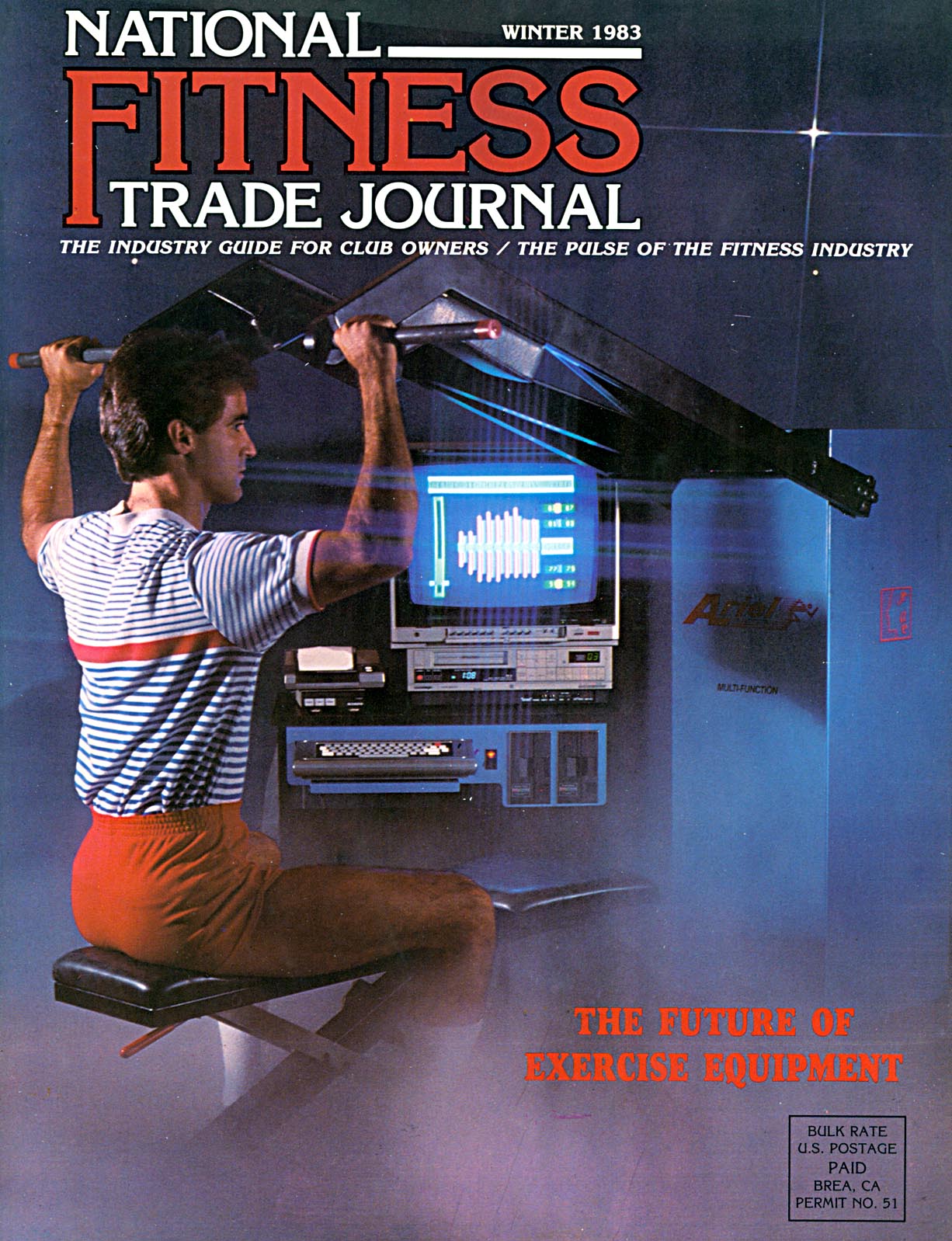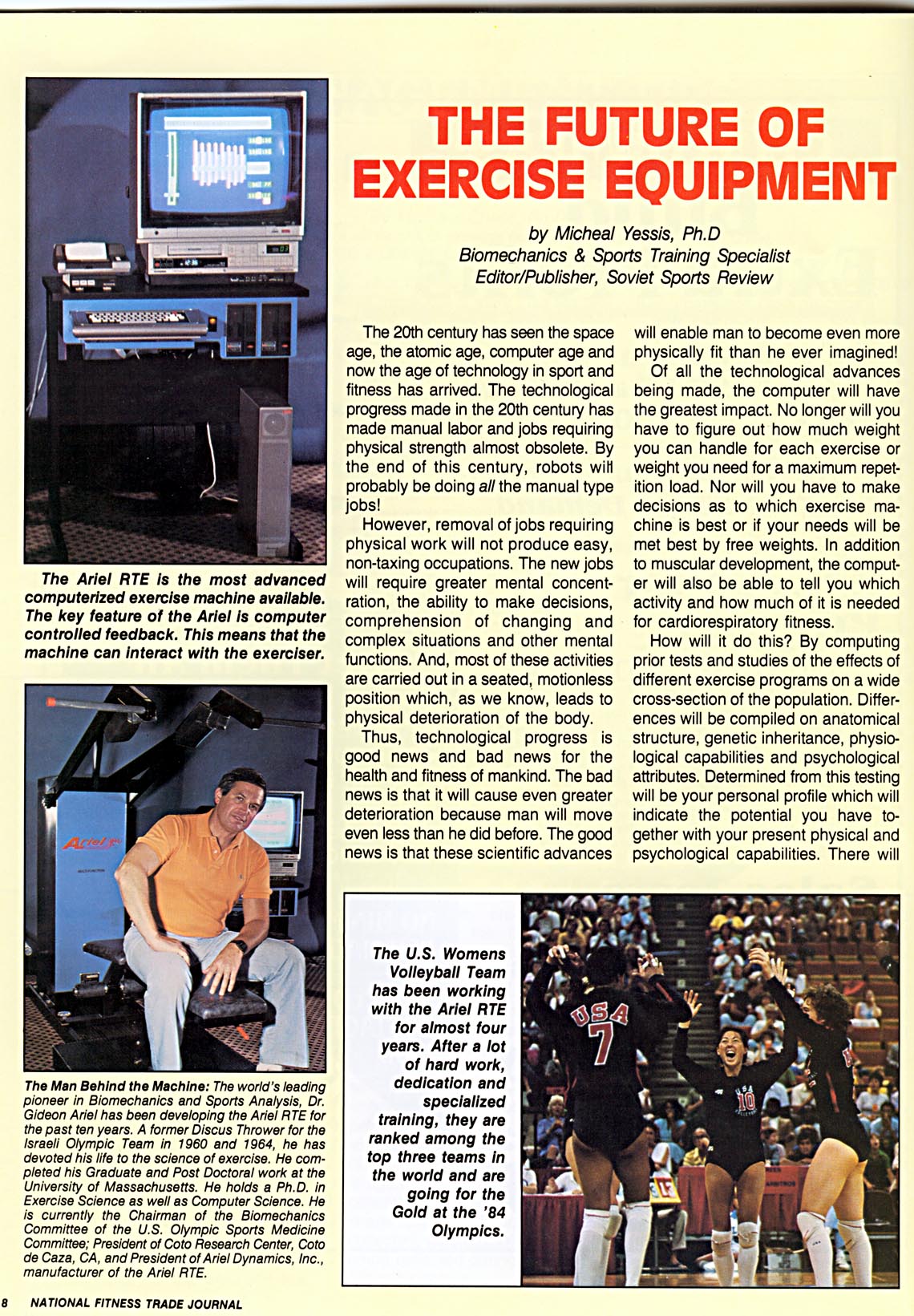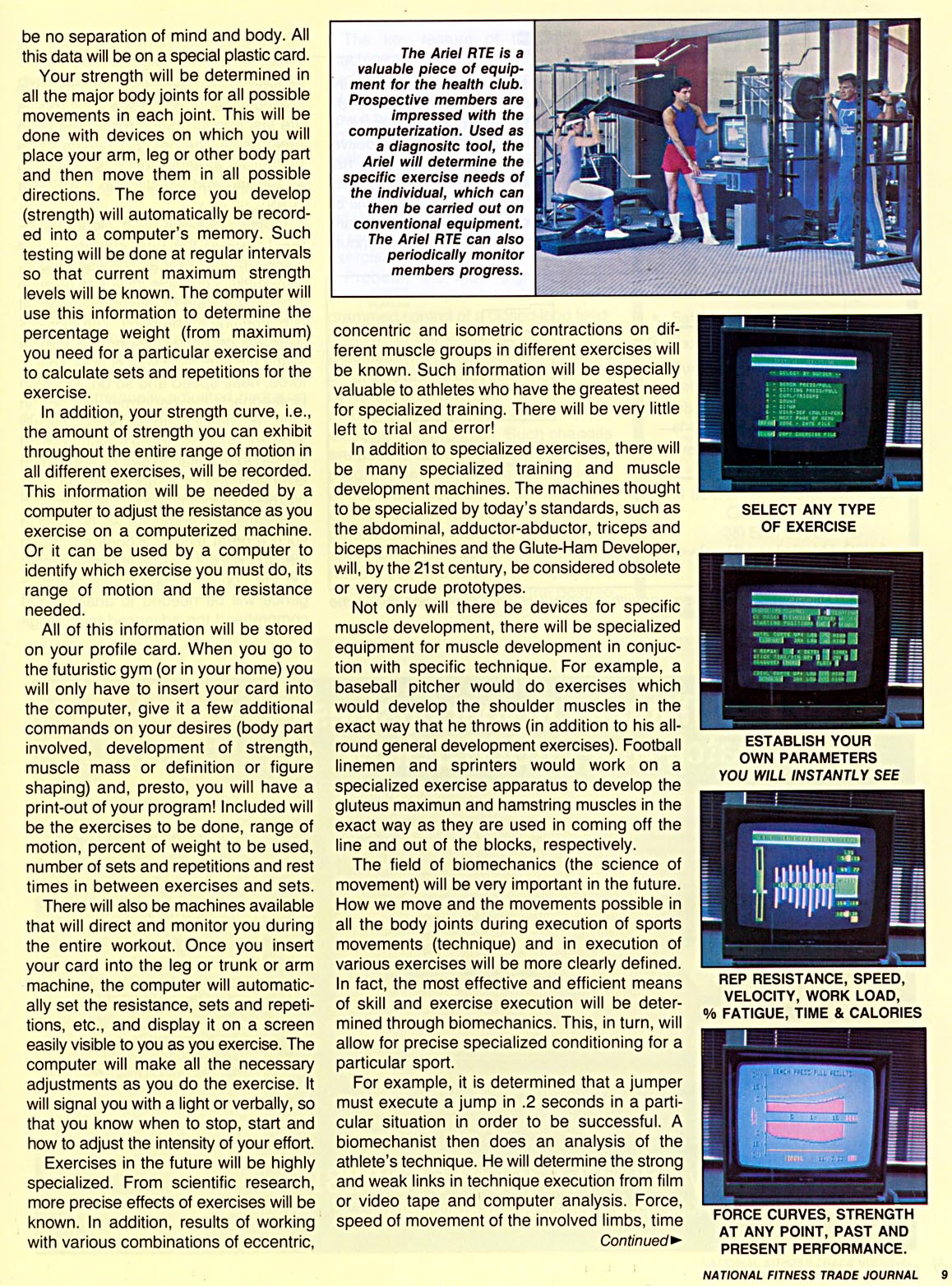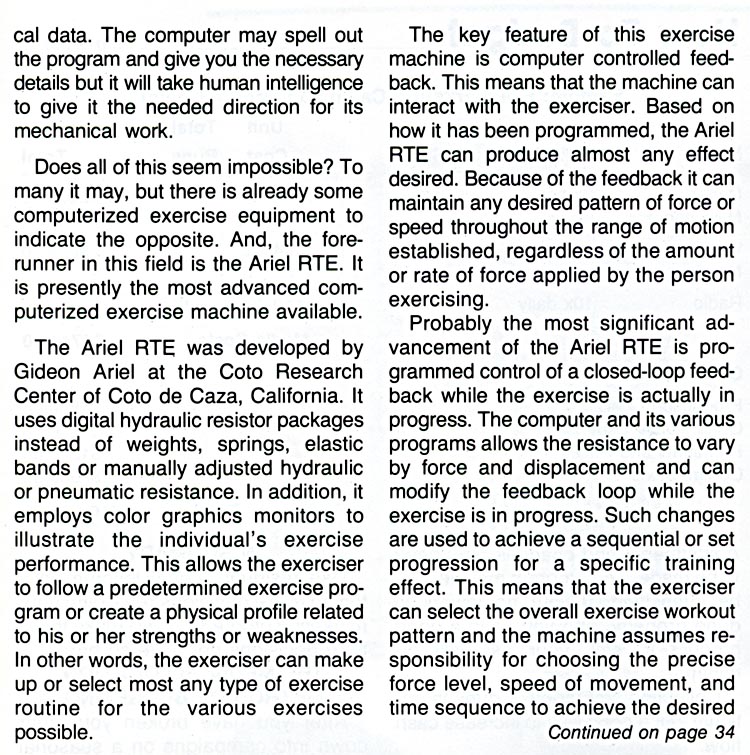The Future Of Exercise equipment
The U.S. Womens Volleyball Team has been working with the Ariel RTE for almost four years.
By Micheal Yessis in National Fitness Trade Journal on Thursday, December 1, 1983
The Future of Exercise Equipment
In this article, Micheal Yessis, a Biomechanics & Sports Training Specialist, discusses the future of exercise equipment, focusing on the Ariel RTE, the most advanced computerized exercise machine currently available. The Ariel RTE uses computer-controlled feedback to interact with the user, adjusting resistance and exercise parameters based on the user's performance.
The article highlights how technological advancements are impacting the fitness industry, with the potential for more personalized and efficient workouts. The Ariel RTE, developed by Dr. Gideon Ariel, a pioneer in Biomechanics and Sports Analysis, uses digital hydraulic resistor packages instead of traditional weights and employs color graphics monitors to illustrate the individual's exercise performance.
The machine can adapt to the user's needs, adjusting resistance, sets, and repetitions automatically. It can also provide a visual display of the user's performance, allowing for immediate comparisons to previous workouts. The Ariel RTE is seen as a precursor to future exercise equipment, which will likely be more automated and specialized, catering to the specific needs of the user.
The article also touches on the future of rehabilitation and restoration, nutrition, and the potential impact of technology on sports competitions.
Tip: use the left and right arrow keys
THE FUTURE OF EXERCISE EQUIPMENT
by Micheal Yessis, Ph.DBiomechanics & Sports Training SpecialistEditor/Publisher, Soviet Sports Review
The Ariel RTE Is the most advanced computerized exercise machine available. The key feature of the Ariel Is computer controlled feedback. This means that the machine can interact with the exerciser.
The 20th century has seen the space age, the atomic age, computer age and now the age of technology in sport and fitness has arrived. The technological progress made in the 20th century has made manual labor and jobs requiring physical strength almost obsolete. By the end of this century, robots wih probably be doing all the manual type jobs!
However, removal of jobs requiring physical work will not produce easy, non-taxing occupations. The new jobs will require greater mental concentration, the ability to make decisions, comprehension of changing and complex situations and other mental functions. And, most of these activities are carried out in a seated, motionless position which, as we know, leads to physical deterioration of the body.
Thus, technological progress is good news and bad news for the health and fitness of mankind. The bad news is that it will cause even greater deterioration because man will move even less than he did before. The good news is that these scientific advances will enable man to become even more physically fit than he ever imagined!
Of all the technological advances being made, the computer will have the greatest impact. No longer will you have to figure out how much weight you can handle for each exercise or weight you need for a maximum repetition load. Nor will you have to make decisions as to which exercise machine is best or if your needs will be met best by free weights. In addition to muscular development, the computer will also be able to tell you which activity and how much of it is needed for cardiorespiratory fitness.
How will it do this? By computing prior tests and studies of the effects of different exercise programs on a wide cross-section of the population. Differences will be compiled on anatomical structure, genetic inheritance, physiological capabilities and psychological attributes. Determined from this testing will be your personal profile which will indicate the potential you have together with your present physical and psychological capabilities. There will
The Man Behind the Machine: The world's leading pioneer in Biomechanics and Sports Analysis, Dr. Gideon Anal has been developing the Ariel RTE for the past ten years. A former Discus Thrower for the Israeli Olympic Team in 1960 and 1964, he has devoted his life to the science of exercise. He completed his Graduate and Post Doctoral work at the University of Massachusetts. He holds a Ph.D. in Exercise Science as well as Computer Science. He is currently the Chairman of the Biomechanics Committee of the U.S. Olympic Sports Medicine Committee; President of Coto Research Center, Coto de Caza, CA, and President of Anal Dynamics, Inc., manufacturer of the Ariel RTE.
The U.S. Womens Volleyball Team has been working with the Ariel RTE for almost four years. After a lotof hard work, dedication and specialized training, they are ranked among the top three teams inthe world and are going for the Gold at the '84 Olympics.
NATIONAL FITNESS TRADE JOURNAL
be no separation of mind and body. All this data will be on a special plastic card.
Your strength will be determined in all the major body joints for all possible movements in each joint. This will be done with devices on which you will place your arm, leg or other body part and then move them in all possible directions. The force you develop (strength) will automatically be recorded into a computer's memory. Such testing will be done at regular intervals so that current maximum strength levels will be known. The computer will use this information to determine the percentage weight (from maximum) you need for a particular exercise and to calculate sets and repetitions for the exercise.
In addition, your strength curve, i.e., the amount of strength you can exhibit throughout the entire range of motion in all different exercises, will be recorded. This information will be needed by a computer to adjust the resistance as you exercise on a computerized machine. Or it can be used by a computer to identify which exercise you must do, its range of motion and the resistance needed.
All of this information will be stored on your profile card. When you go to the futuristic gym (or in your home) you will only have to insert your card into the computer, give it a few additional commands on your desires (body part involved, development of strength, muscle mass or definition or figure shaping) and, presto, you will have a print-out of your program! Included will be the exercises to be done, range of motion, percent of weight to be used, number of sets and repetitions and rest times in between exercises and sets.
There will also be machines available that will direct and monitor you during the entire workout. Once you insert your card into the leg or trunk or arm machine, the computer will automatically set the resistance, sets and repetitions, etc., and display it on a screen easily visible to you as you exercise. The computer will make all the necessary adjustments as you do the exercise. It will signal you with a light or verbally, so that you know when to stop, start and how to adjust the intensity of your effort.
Exercises in the future will be highly specialized. From scientific research, more precise effects of exercises will be known. In addition, results of working with various combinations of eccentric,
The Ariel RTE is a valuable piece of equip ment for the health club.Prospective members are impressed with the computerization. Used as a diagnositc tool, theAriel will determine the specific exercise needs of the individual, which can then be carried out onconventional equipment.The Ariel RTE can also periodically monitor members progress.
concentric and isometric contractions on different muscle groups in different exercises will be known. Such information will be especially valuable to athletes who have the greatest need for specialized training. There will be very little left to trial and error!
In addition to specialized exercises, there will be many specialized training and muscle development machines. The machines thought to be specialized by today's standards, such as the abdominal, adductor-abductor, triceps and biceps machines and the Glute-Ham Developer, will, by the 21st century, be considered obsolete or very crude prototypes.
Not only will there be devices for specific muscle development, there will be specialized equipment for muscle development in conjuction with specific technique. For example, a baseball pitcher would do exercises which would develop the shoulder muscles in the exact way that he throws (in addition to his allround general development exercises). Football linemen and sprinters would work on a specialized exercise apparatus to develop the gluteus maximun and hamstring muscles in the exact way as they are used in coming off the line and out of the blocks, respectively.
The field of biomechanics (the science of movement) will be very important in the future. How we move and the movements possible in all the body joints during execution of sports movements (technique) and in execution of various exercises will be more clearly defined. In fact, the most effective and efficient means of skill and exercise execution will be determined through biomechanics. This, in turn, will allow for precise specialized conditioning for a particular sport.
For example, it is determined that a jumper must execute a jump in .2 seconds in a particular situation in order to be successful. A biomechanit then does an analysis of the athlete's technique. He will determine the strong and weak links in technique execution from film or video tape and computer analysis. Force, speed of movement of the involved limbs, time
Continued o
SELECT ANY TYPEOF EXERCISE
ESTABLISH YOUROWN PARAMETERSYOU WILL INSTANTLY SEE
REP RESISTANCE, SPEED, VELOCITY, WORK LOAD, FATIGUE, TIME & CALORIES
FORCE CURVES, STRENGTH AT ANY POINT, PAST AND PRESENT PERFORMANCE.
NATIONAL FITNESS TRADE JOURNAL 9
THE FUTURE OF EXERCISE
from page 9
of movement, range of motion and other movement parameters of his jump would be determined. Exercises will then be prescibed to perfect technique and to improve strength and power where needed so that he would be able to execute a successful jump in the required time.
Robots will be developed to test the effectiveness of various conditioning programs undertaken by athletes in different contact sports. For example, in boxing, will a fighter be able to deliver a blow against an opponent who has exceptionally fast reaction time to block the punch? To find out, a robot will be programmed to execute a block or parry to the particular hit in a certain amount of time. The boxer then "fights" the computerized robot to see if his moves are fast enough. Such robots will be in great use in the next 5-10 years since prototypes already exist in sports such as fencing and wrestling in the Soviet Union.
Biofeedback will be a highly developed area in the next century. It will allow for total body awareness, that is, it will make it possible for you to develop a complete state of awareness of what is happening to the body. The biofeedback will be multi-sensory and involve all the different receptors of time, space, force, heat, speed and so on. Through biofeedback the performer will be "in tune" maximally with his body. This will allow for truly instinctive training (which is used to a limited extent by some high level athletes) as a supplement to what has been programmed by the computer.
Because the computer will be used to such a great extent, it does not mean that you will not need great intelligence. On the contrary! High levels of intelligence will be needed to analyze and comprehend the advanced technologi-
The Ariel RTE will supply the exerciser with a printout of what took place during the execution of the exercise,
cal data. The computer may spell out the program and give you the necessary details but it will take human intelligence to give it the needed direction for its mechanical work.
Does all of this seem impossible? To many it may, but there is already some computerized exercise equipment to indicate the opposite. And, the forerunner in this field is the Ariel RTE. It is presently the most advanced computerized exercise machine available.
The Ariel RTE was developed by Gideon Ariel at the Coto Research Center of Coto de Caza, California. It uses digital hydraulic resistor packages instead of weights, springs, elastic bands or manually adjusted hydraulic or pneumatic resistance. In addition, it employs color graphics monitors to illustrate the individual's exercise performance. This allows the exerciser to follow a predetermined exercise program or create a physical profile related to his or her strengths or weaknesses. In other words, the exerciser can make up or select most any type of exercise routine for the various exercises possible.
The key feature of this exercise machine is computer controlled feedback. This means that the machine can interact with the exerciser. Based on how it has been programmed, the Ariel RTE can produce almost any effect desired. Because of the feedback it can maintain any desired pattern of force or speed throughout the range of motion established, regardless of the amount or rate of force applied by the person exercising.
Probably the most significant advancement of the Ariel RTE is programmed control of a closed-loop feedback while the exercise is actually in progress. The computer and its various programs allows the resistance to vary by force and displacement and can modify the feedback loop while the exercise is in progress. Such changes are used to achieve a sequential or set progression for a specific training effect. This means that the exerciser can select the overall exercise workout pattern and the machine assumes responsibility for choosing the precise force level, speed of movement, and time sequence to achieve the desired
Continued on page 34
This does not mean the machine does the work! It merely allows you to exercise as you desire, automatically, without having to stop and make adjustments or changes during execution of the exercise.
During the workout the exerciser can see exactly what he is doing. Upon completion, he can get a visual display of force generated in each repetition, range of motion, speed of movement and so on. In addition, he can get immediate comparisons to previous performances of the same exercise. And, if desired, the exerciser can get a printout of what took place during execution of the exercise. All of this is available with only the punching of a few keys on the computer keyboard.
To give you a better picture of how the Ariel RTE functions, following are 2 examples of how it is used: 1) An exerciser wants to pyramid his exercise routine starting at 1/2 body weight and increasing each repetition by 10% until he cannot continue. To do this, he would first support himself on the exercise bar to determine body weight. The computer would then select the pattern of increasing force starting at precisely half his body weight and automatically increase the resistance by 10% after each repetition until failure. At this point it would report the final force level, the number of repetitions and, if desired, the progress made since the last workout.
To do this with conventional weights would require stopping after each repetition to change the resistance, during which time the muscles would recover slightly. Because of the extra time involved and muscle recovery, the exercise would, in essence, become different.
- A lifter wants to exercise with a constant force or predetermined force pattern with a 3 second stop at the weakest point for additional strength. The computer does this automatically when given the directions. In addition, it can display the level of strength at the "sticking point" and compare it to previous levels and to the strength over the entire range of motion.
The Ariel RTE is also capable of providing a resistance in either direction of motion. This gives a pulling and pushing action to the exercise which involves the agonist and antagonist muscles in each repetition.
The feedback nature of this exercise machine also allows for controlled movement or movement at a set speed (or force). It does this by changing the resistance to match the "expected" outcome (what has been programmed). After receiving information on what the exerciser did in the previous repetition, the machine adjusts the resistance automatically to keep the force (speed) as required.
Futuristic conditioning will entail more than just computerized exercise machines. The areas of rehabilitation and restoration will also be highly developed as an adjunct to physical conditioning. For example, it is not inconceivable that broken bones will be sealed in a matter of minutes with special bonding materials. Pulled or strained muscles will be treated and cured in specialized chambers using magnetic and electrical waves or pressure changes with different heat
Continued on page 38
THE FUTURE OF EXERCISE
THE FUTURE OF EXERCISE from page 34
treatments. Experimentation has already begun in this area and will be well developed by the 21st century.
Physiotherapy and other means of recuperation will abound in the near future to quickly and fully recuperate the athlete or fitness advocate. Can't you just picture lying in a pool with jets of different mineral waters shooting out at you, getting different massages under and above water, sipping on an oxygen cocktail, munching on vitamin-mineral cookies and listening to therapeutic music and experiencing changing soothing lights! All of these measures will fully restore your body after workouts. You will not experience any lingering fatigue which will limit you in your daily activities. For the latest information in these areas see recent issues of the Soviet Sports Review.
Nutrition will also play a major role in conditioning. Because of the highly sophisticated exercise and fitness program, you will have to have all the necessary food stuffs to supply the body with the energy needed to work out. Today, nutritionists are only beginning to
determine the specific needs of physically active individuals for both doing the work needed in their sport and for recuperating.
Science will have the technology developed to quickly determine which foods are best assimilated by certain people, which nutrients are lacking and so on. This will enable coaches, club instructors and others to constantly monitor the nutritional state of their charges.
It should now be evident that conditioning in the future will be highly automated and very specialized. It will be possible for you to get precise development to fit your needs whether they be in athletics or in your occupations and avocations. Specialized exercise machines will abound which will help you develop specific muscles and body areas, improve your physical abilities and develop specific strength for specific sports skills.
However, this does not mean that today's exercise equipment will be obsolete. There will still be dumbbells, barbells, and all-round single and multiple exercise machines, even though they may have futuristic designs and be made of different materials. Some present day equipment will continue to be used for general and specialized conditioning work which cannot be duplicated by computerized machines (at least at this time).
The peripheral aspects of conditioning will also be highly developed and quite specialized. Warm-ups, cooldowns, energy supply (nutrition), restoration and rehabilitation will be sufficiently advanced to keep you participating on a steady basis with maximum efficiency with few, if any, major setbacks or changes in your daily fitness level.
Because of the very complex and specialized conditioning programs, competition in sport and other activities may be very different. Will the computer be used to judge sporting events? Will it be used to evaluate competitors on both a physical and esthetic basis? Will spectators need computerized machines and television sets to discern differences in sports performances in minute detail? What will spectators expects to have to satisfy their needs and tastes? The answers will be known sooner than you think!
Peter C. Siegel, R.H.
The Ariel RTE is the most advanced form of exercise equipment available in the world today. Offering optimum training for general fitness, bodybuilding, athletics and powerlifting - it establishes fitness and strength profiles and evaluates the users progress. The advantages for health clubs are tremendous. Potential members will be Impressed with the advanced technology. The Ariel has a "Self Instruction" feature which means that your clients can operate it by themselves, freeing your staff for other functions. It is completely compatible with all conventional equipment as well as free weights. Use it as a diagnostic tool, it will develop workout programs for members to use on your existing equipment. Set up a schedule for members to use it once a week or once a month, they will get instant feedback on how they have progressed. Invest in the future, it's here today!
REP RESISTANCE. SPEED.VELOCITY. WORK LOAD,% FATIGUE, TIME & CALORIES
FORCE CURVES, STRENGTH AT ANY POINT, PAST AND PRESENT PERFORMANCE.
~rie/
DYNAMICS INC
Coto Research Center, Coto de Caza, CA 92678 (714) 568-4113








